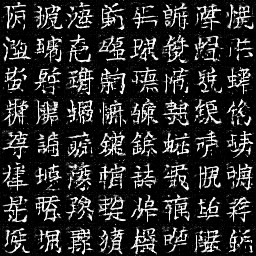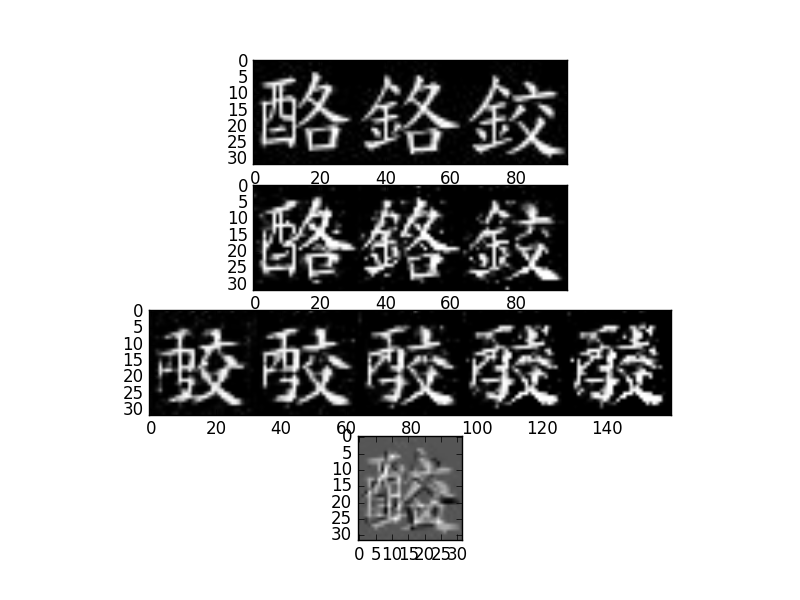Implementation (with modifications) of Autoencoding beyond pixels using a learned similarity metric
The modification is as follows: I added a Tanh layer to the latent variable z, converting the space of R into [-1, 1]. This modification is emperimental.
*Please refer to their official Github for details*: https://github.com/andersbll/autoencoding_beyond_pixels
As the name indicates, VAE-GAN replaces GAN's generator with a variational auto-encoder, resulting in a model with both inference and generation components. I explored the latent space and find some interesting properties.
Ubuntu 16.04 ([Optional] to download data using wget)
Python 3.5
- Tensorflow v0.12
- Matplotlib
- PIL
Dataset: 20,000 Chinese characters (each with only one *.png file) obtained from 全字庫.
Network architecture: VAE-GAN implemented with CNN, specified in architecture.json
The right-most and the left-most images are real images.
The second right/left-most images are self-reconstructions.
The rest of the images are interpolations.
These images were generated during training procedures.
These images were generated during training procedures.
I'm interested in carrying out simple arithmetics in the latent space just as what the authors demonstrated in Word2vec and DC-GAN. In the following example, I found that the latent space was truly meaningful, though it was different than I had expected.
Chinese characters are formed by many fundamental parts. For example, the word 酪 (chese) has two parts: the left is a 酉 denoting its characteristics (related to "ferment") and the right is a 各 (individual) hinting its pronouciation. I'd like to know if it's possible to create visually plausible characters that doesn't exist in Chinese.
Figure: Character arithmetic expample of "A - B + C."1st panel (from top): the original images of the input (A, B, and C)
2nd panel: the reconstructed images from VAE-GAN.
3rd panel: I carried out "D = a*(A - B + C)" in the latent space and then generate an image from D.
The coefficient a is [0.25, 0.5, 1, 2, 3] from left to right.
4th panel: "A - B + C" in the input domain.
In this case, A=酪(cheese), B=鉻 (chromium), and C=鉸 (scissors). A and B have a commom right part of 各 (individual); B and C have a common left part of 金 (metal). Therefore, we expect that conceptually A - B + C should result in a character with 酉 (right part of A) and 交 (left part of C). There is actually no character [酉交] in Chinese, but we want to see if we can create one (and it seems that we can).
The gamma parameter in Eq. (9) is a trade-off between style and content as mentioned in the paper. In my experiment, if gamma is set too small (such as 1e-5), the content could be lost, thus unable to reconstruct the input. However, random sampls directly generated from the latent space were realistic in this case. Setting gamma to a larger value (say, 0.1), we ended up with a good reconstruction, but the random samples could be less reasonable to the eyes.
Please modify test.txt file which contains the "A B C" tuples (one tuple per line)
./get_data.sh
python validate --checkpoint logdir/train/pretrained/model.ckpt-31200It'll give you a bunch of generated images as described in the "Character Arithmetics" section.
python train.py --dataset [your dataset] [options]Note:
0. If you have get the Chinese character dataset by ./get_data.sh, you can simply run python train.py to re-run my training using the same dataset.
- You can modify
architecture.jsonto try different network specifications. - You can use the Tensorboard to track the training.
- I disabled embedding viewer in my training script. You you wanna use it, please modify and run
make_sprite.pyandpython make_tsv.py


